The Importance of Warning Labels In-Cosmetics.
Blue indicates link
When reading this article you will notice some big chemical names, please do not use any product that contains any one of these toxins. Certain companies have re-named these toxins. I know Johnson and Johnson are suspected of doing this with their talc powder.
Talc Powder
For several years Johnson and Johnson have been selling Baby Talc Powder. I know my mum used it, my whole family used it. It is linked to many forms of cancer and they will not put warning labels on it. The cosmetic industry is not regulated very closely by the FDA unless it is too late. Why the big names? These companies are giants and there is a lot of money involved. Money may come first.
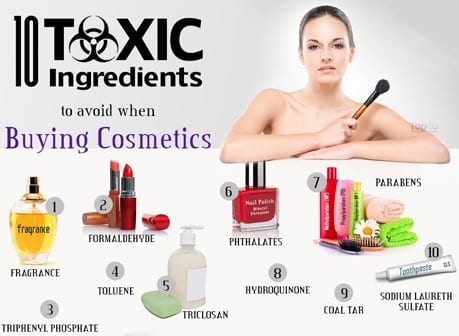
Johnson’s and Johnson’s Talc powder, (Baby Powder) Judgement.
A Missouri jury on Thursday ordered Johnson & Johnson to pay a record $4.69 billion to 22 women who alleged the company’s talc-based products, including its baby powder, contain asbestos and caused them to develop ovarian cancer.
(Natural News) Johnson & Johnson (J& J) is the subject of a California lawsuit alleging that the company colluded with pharmaceutical consultant Omnicare to push its drugs on nursing home residents. Among the charges are allegations that J& J violated federal Medicaid laws with its schemes to maximize profits.
Johnson and Johnson’s Questionable Ingredients:
Johnson and Johnson label many of their bath products as being “baby-safe”. However, their shampoos, soaps, and lotions contain questionable ingredients detrimental to the health of babies and their parents.
The Environmental Working Group, a nonprofit environmental research organization, lists concerns over Johnson and Johnson’s multiple additive exposure sources; skin, eye, and lung irritants; cytotoxic ingredients; endocrine disruptors; neurotoxins; and bioaccumulative carcinogens.
Two of the most concerning ingredients are Quaternium-15 and 1,4 dioxane.
Quaternium-15 releases formaldehyde, a well-known carcinogen that causes watery eyes; burning sensations in the eyes, nose, and throat; coughing; wheezing; nausea; and skin irritation. Daily exposure is linked to leukemia and brain cancer. Other formaldehyde-releasing chemicals used by Johnson & Johnson include DMDM hydantoin, imidazolidinyl urea, and Diazolidinyl urea. Johnson & Johnson “admitted” that their brand baby products contain formaldehyde, which is a known carcinogen.
Johnson & Johnson pledged last August 2012 to eliminate formaldehyde, parabens, triclosan, and phthalates from all baby products. For adult products, it has removed triclosan and phthalates but will keep using three parabens, and use formaldehyde in exceptional cases where other preservatives wouldn’t work, according to the company’s new policy.
Ask Yourself if have you ever used any of these Johnson & Johnson products. Especially the Talc powder?
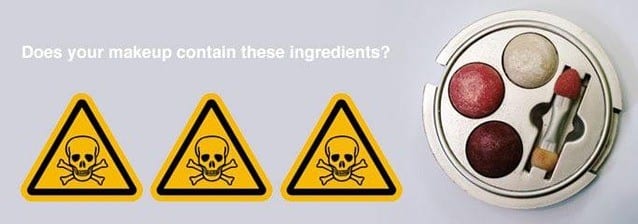
Let Us Look At Some of The Other Chemicals Used In Cosmetic Products.
1,4-DIOXANE
Not listed on ingredient labels, 1,4-dioxane is a contaminant linked to cancer found in products that create suds, such as shampoo and liquid soap.
This compound is irritating to the eyes and respiratory tract. Exposure may cause damage to the central nervous system, liver, and kidneys. In a 1978 mortality study conducted on workers exposed to 1,4-dioxane, the observed number of deaths from cancer was not significantly different from the expected number.
ACRYLATES
Acrylates (ethyl acrylate, ethyl methacrylate, and methyl methacrylate) are ingredients found in artificial nail products.
HEALTH CONCERNS: Health concerns include cancer, developmental and reproductive toxicity, organ system toxicity, cellular and neurological damage, and irritation.
REGULATIONS: Although the Food and Drug Administration banned 100 percent liquid methyl methacrylate in 1974, no specific regulations prohibit its use at concentrations lower than 100 percent in cosmetic products. Across the United States, at least 32 states ban the professional use of methyl methacrylate in nail salons. Still, the FDA found trace amounts in 15 to 25 random samples of the chemical in powdered form and reports that it continues to be found in artificial nail products.
Air samples from 12 randomly selected nail salons in Salt Lake City County in Utah, which banned methyl methacrylate, found 58 percent of the salons had methyl methacrylate circulating in the air. Considering the corrosive and skin-sensitizing properties of ethyl methacrylate and methyl methacrylate, the Methacrylate Producers Association, Inc. has stated that these chemicals are not appropriate for artificial nail products. Yet, they continue to be ingredients.
BENZOPHENONE & RELATED COMPOUNDS
A chemical linked to cancer, benzophenone is used in cosmetics such as lip balm and nail polish to protect the products from UV light.
Benzophenone is used in personal care products such as lip balm and nail polish to protect the products from UV light. Derivatives of benzophenone, such as benzophenone-2 (BP2) and oxybenzone (benzophenone-3 or BP3) are common ingredients in sunscreen. Benzophenone is persistent, bioaccumulative, and toxic (PBT). These chemicals are linked to cancer, endocrine disruption, and organ system toxicity.
FOUND IN: Lip balm, nail polish, foundations, baby sunscreens, fragrance, shampoo, conditioner, hair spray, moisturizers, and foundation
WHAT TO LOOK FOR ON THE LABEL: Benzophenone, ingredients containing the word benzophenone (for example benzophenone-2), BP# (for example BP2), oxybenzone, sulisobenzone and sulisobenzone sodium.
WHAT IS BENZOPHENONE?
Benzophenone is widely used in household products, such as sunglasses, food packaging, laundry, and cleaning products to protect from UV light.
HEALTH CONCERNS: Cancer, endocrine disruption, developmental and reproductive toxicity, organ system toxicity, irritation, ecotoxicity.
VULNERABLE POPULATIONS: Women and infants
REGULATIONS: Benzophenone, benzophenone-2, benzophenone-3, benzophenone-4, and benzophenone-5 are restricted in cosmetics in the United States and oxybenzone is restricted in cosmetics at up to 10% maximum concentration in the EU.
HOW TO AVOID: Read labels and avoid products containing these chemicals. Choose sunscreens that rely on non-nanoized zinc oxide or titanium dioxide.
Butylated hydroxyanisole (BHA) and butylated hydroxytoluene (BHT) are used as preservatives in a variety of personal care products. Both of these chemicals are also used as preservatives in foods. These chemicals are linked to several health concerns including endocrine disruption and organ-system toxicity.
FOUND IN: Lip products, hair products, makeup, sunscreen, antiperspirant/deodorant, fragrance, creams
WHAT TO LOOK FOR ON THE LABEL: BHA, BHT
WHAT ARE BUTYLATED COMPOUNDS?
BHA is primarily used as an antioxidant and preservative in food, cosmetics, food packaging, and animal feed.
HEALTH CONCERNS: Endocrine disruption, organ-system toxicity, developmental and reproductive toxicity, cancer, irritation.
VULNERABLE POPULATIONS: Pregnant women, infants.
HOW TO AVOID: Read labels and avoid products that contain BHA or BHT.
Concerns about organ-system toxicity and endocrine disruption led the European Union to prohibit the preservative butylated hydroxyanisole (BHA) from cosmetics.
Carbon black is a dark black powder used as a pigment in cosmetics such as eyeliner, mascara, and lipstick that has been linked to increased incidence of cancer.
CARCINOGENS IN COSMETICS
The laws governing cosmetics and personal care products are so limited that known cancer-causing chemicals are legally allowed in personal care products.
Coal tar is a known carcinogen found in shampoos, soaps, hair dyes, and lotions.
ETHANOLAMINE COMPOUNDS (MEA, DEA, TEA, AND OTHERS)
Diethanolamine (DEA) is a type of ethanolamine, a chemical widely used in cosmetics. The European Union prohibits DEA in cosmetics due to concerns about the formation of carcinogenic nitrosamines.
FORMALDEHYDE AND FORMALDEHYDE-RELEASING PRESERVATIVES
Cancer-causing formaldehyde and formaldehyde-releasing preservatives are often found in shampoos and liquid baby soaps.
HYDROQUINONE
One of the most toxic ingredients used in personal care products, hydroquinone is primarily associated with use in skin lighteners marketed to women of color.
LEAD AND OTHER HEAVY METALS
Heavy metals like lead, arsenic, and mercury, are contaminants found in a wide variety of personal care products including lipstick, whitening toothpaste, eyeliner, and nail color.
NAIL POLISH REMOVERS
A serious concern for nail salon workers and pregnant women, nail polish removers are linked to reproductive harm and organ toxicity.
Parabens are preservatives used in a wide variety of personal care products. These endocrine-disrupting chemicals can be absorbed through the skin, blood, and digestive system.
Found in facial moisturizers, anti-aging products, and more, polyacrylamide can break down into the known carcinogen acrylamide.
Banned from cosmetics in the European Union, phthalates are widely used in color cosmetics, fragranced lotions, body washes, and other products sold in the United States.
Found in nail polish and hair dyes, toluene is restricted for use in the European Union, but not in the United States.
Triclosan, which has been linked to hormone disruption and antibiotic resistance, can be found in soaps, detergents, kinds of toothpaste, deodorants, and more.
FOUND IN: Baby powder, body and shower products, lotions, feminine hygiene products, eye shadow, foundation, lipstick, deodorants, and face masks.
WHAT TO LOOK FOR ON THE LABEL: Talcum powder, cosmetic talc.
WHAT IS TALC? Talc is a mineral substance used in a variety of cosmetic and personal care products from baby powders to eye shadows. It is added to absorb moisture, smooth or soften products, prevent caking and make makeup opaque.
HEALTH CONCERNS: Irritation, cancer, organ system toxicity.
VULNERABLE POPULATIONS: Women, infants, children, miners, millers, and processors of talc.
REGULATIONS: Talc is restricted in the European Union. Still available in North America.
HOW TO AVOID: Avoid personal care and cosmetic products that contain talc if used in the pelvic area. Choose companies that certify their talc is free of asbestos.
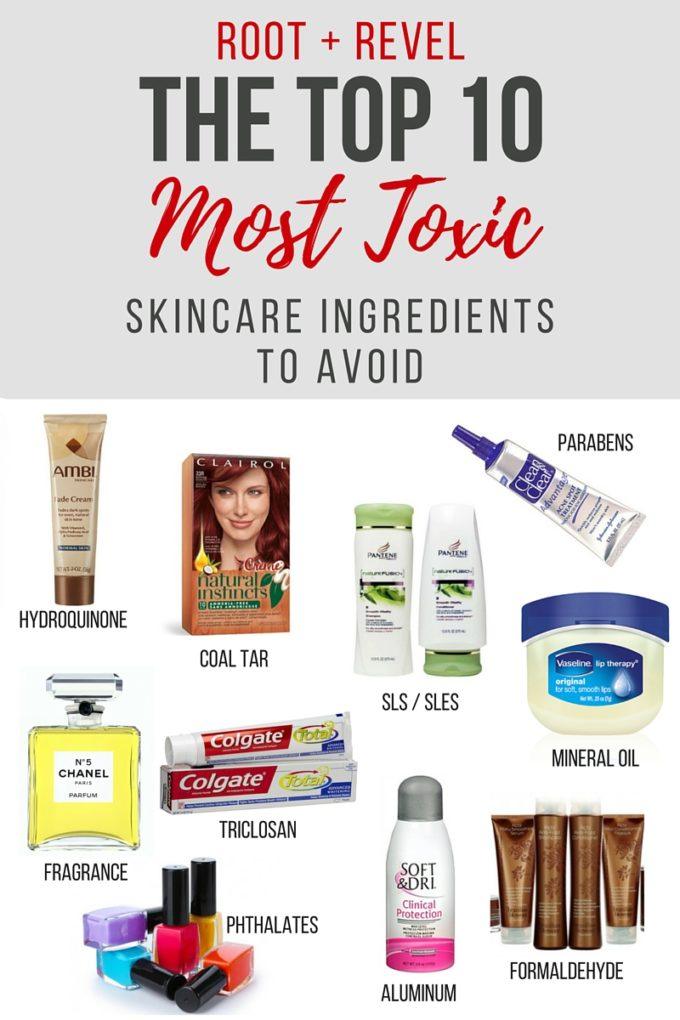
Retinol is the chemical name of the essential micronutrient vitamin A which can be harmful to your health when it’s added to a cosmetic.
Retinol is the chemical name of the essential micronutrient vitamin A which can be harmful to your health when it’s added to cosmetic products in certain forms.
Two derivatives – retinoic acid and retinyl palmitate – should be avoided in cosmetics and personal care products while retinol itself should not be used at high doses.
FOUND IN: Anti-aging creams and lotions, moisturizers, and foundation.
WHAT IS RETINOL? Natural vitamin A and its derivatives have important roles in human reproduction and development and in maintaining good vision and healthy skin.
People must consume enough vitamin A from their diet to be healthy.
WHAT TO LOOK FOR ON THE LABEL: Retinol, vitamin A, retinyl acetate, retinyl palmitate, all-trans retinoic acid, and tretinoin.
HEALTH CONCERNS: Cancer (Possible), Developmental, and reproductive toxicity. More
VULNERABLE POPULATIONS: All
Styrene acrylates copolymer is a chain of polymers consisting of styrene and acrylate which is added to cosmetics for color. There is the…
Styrene acrylates copolymer is a chain of polymers consisting of styrene and acrylate which is added to cosmetics for color. There is the potential for styrene acrylates copolymer to be contaminated with styrene, a possible carcinogen.
FOUND IN: Styrene acrylates copolymer and related styrene-based polymers are most often found in nail polish, sunscreen (SPF greater than 30), sunscreen moisturizer, body wash/cleanser, shampoo, and eyeliner.
WHAT TO LOOK FOR ON THE LABEL: Styrene/acrylates copolymer, styrene-butadiene copolymer, polystyrene, styrene copolymer, styrene resin, ethylbenzene, and vinyl benzene.
WHAT IS STYRENE ACRYLATES COPOLYMER: Styrene acrylates copolymer is a chain of polymers consisting of styrene and acrylate which is added to cosmetics for color. There is a contamination concern with this ingredient and related ingredients.
HEALTH CONCERNS: Styrene acrylates copolymer is considered safe because there is a low likelihood of absorption of the full compound. However, contamination with the possible carcinogen styrene is a concern.
In our 2016 report focusing on kids’ makeup products, our lab results found trace amounts of residual styrene in one stick-on nail product. The residual styrene was most likely the result of residual styrene in the styrene-acrylates copolymer, an ingredient listed on the label.
Styrene is also one of almost 3,000 chemicals listed by the International Fragrance Association (IFRA) as being used in fragrance. The product that contained styrene did not have fragrance as a listed ingredient, but it is theoretically possible that fragrance ingredients could contain trace levels of styrene. Our tests did not reveal detectable levels of styrene in fragrance products tested.
VULNERABLE POPULATIONS: Everyone.
REGULATIONS: Determined safe for use in cosmetics, subject to concentration or use limitations – Safe for use in cosmetics with some qualifications.
HOW TO AVOID: Read product ingredient labels, and avoid items with fragrance or styrene acrylates copolymer listed as ingredients.
QUATERNIUM-15
Quaternium-15, a known skin toxicant, an allergen may be especially dangerous for hairdressers and janitors, who are sometimes exposed to…
Quaternium-15, a known skin toxicant, an allergen may be especially dangerous for hairdressers and janitors, who are sometimes exposed to this formaldehyde-releasing chemical at regular doses for long periods of time.
FOUND IN: Hair conditioners, hair styling products, creams, lotions, cleansers, shaving products, eye drops contact solutions, and household cleaning products.
WHAT TO LOOK FOR ON THE LABEL: Benzalkonium chloride, benzethonium chloride, quaternium-15, cetrimonium bromide, polyquaternium – followed by a number (i.e. polyquaternium-7).
WHAT IS POLYQUATERNIUM: Polyquaternium refers to any polymer that has been modified by a process called quaternization. This process results in changes in molecules that improve the performance of body care products. Polyquaternium may also be referred to as quaternary ammonium compounds (QACs) or simply quats.
HEALTH CONCERNS: Irritation & sensitization.
VULNERABLE POPULATIONS: All populations, particularly hairdressers and janitors.
REGULATIONS: Quaternium-15 is regulated by the Cosmetics Directive of the European Union and can be used up to a maximum concentration of 0.2% in cosmetics and personal care products. In the US, there are currently no regulations for quaternium-15 use in cosmetics.
HOW TO AVOID: Read labels and avoid products that contain quaternary ammonium compounds.
PRESERVATIVES
Preservatives may be used in cosmetics to prevent the growth of harmful bacteria and mold.
Preservatives may be used in cosmetics to prevent the growth of harmful bacteria and mold. Parabens and formaldehyde-releasing preservatives are commonly used preservatives in cosmetic and personal care products.
FOUND IN: Fragrance, lipstick, shampoos, conditioners, lotions, moisturizers, facial and shower cleansers, nail polish, nail glue, hair gel, hair-smoothing products, baby shampoo, body wash/soap, color cosmetics, and anti-aging products.
WHAT TO LOOK FOR ON THE LABEL: Formaldehyde, DMDM hydantoin, quaternium-15, imidazolidinyl urea, Diazolidinyl urea, polyoxymethylene urea, sodium hydroxymethylglycinate, 2-Bromo-2-nitropropane-1,3-diol (bromopol), and glyoxal.
WHAT ARE PRESERVATIVES & WHERE ARE THEY FOUND? Preservatives may be used in cosmetics to prevent the growth of harmful bacteria and mold. Parabens and formaldehyde-releasing preservatives are commonly used preservatives in cosmetic and personal care products.
HEALTH CONCERNS: Cancer, endocrine disruption, developmental toxicity, reproductive toxicity, irritation, and many other health concerns.
VULNERABLE POPULATIONS: Pregnant women, infants/young children, and hair/nail salon workers.
REGULATIONS: Formaldehyde is banned from use in cosmetics and toiletries in Japan and Sweden; in the EU, restricted in personal care products, and labeling is required in products that do contain these chemicals; concentration restrictions in Canada. Some forms of parabens are banned in Denmark (propyl and butylparaben, their isoforms and salts) in cosmetic products for children up to years. The FDA doesn’t have special rules that apply only to preservatives in cosmetics.
European Regulation: The EU regulates what and how much of various preservatives are allowed in cosmetics. It is one of the most comprehensive regulatory cosmetic/personal care guidelines, setting the standard for many regulatory agencies around the world. Included on the list are preservatives such as triclosan, triclocarban, phenoxyethanol, benzyl benzoate, methylisothiazolinone, zinc pyrithione, benzalkonium chloride, benzyl alcohol, and some essential oils.
HOW TO AVOID: Read labels, and avoid products with most parabens and all formaldehyde-releasing preservatives. If you are sensitive to other ingredients (e.g., allergens like methylisothiazolinone), avoid those ingredients as well.
Phenoxyethanol is used as a preservative in cosmetic products and also as a stabilizer in perfumes and soaps.
Phenoxyethanol is used as a preservative in cosmetic products and also as a stabilizer in perfumes and soaps. Exposure to phenoxyethanol has been linked to reactions ranging from eczema to severe, life-threatening allergic reactions. Infant oral exposure to phenoxyethanol can acutely affect the nervous system function.
FOUND IN: Moisturizer, eye shadow, foundation, sunscreen, conditioner, mascara, eyeliner, shampoo, lip gloss, concealer, body wash, hand cream, blush, hair color, hair spray, lip balm, lotion, nail polish, baby wipes, baby lotions and soaps, soap (liquid and bar), shaving cream, deodorant, toothpaste, fragrance, hair removal waxes, hand sanitizer, and ultrasound gel.
WHAT TO LOOK FOR ON THE LABEL: Phenoxyethanol, 2-Phenoxyethanol, Euxyl K® 400 (a mixture of Phenoxyethanol and 1,2-dibromo-2,4-dicyanobutane), Ph.D.
WHAT IS PHENOXYETHANOL? Phenoxyethanol is used as a preservative in cosmetic products to limit bacterial growth. A review of 43 cosmetic products demonstrated that only 25 percent of the products had concentrations of phenoxyethanol greater than 0.6 percent and the mean concentration of phenoxyethanol was 0.46 percent. Phenoxyethanol is also used to stabilize components found in perfumes and soaps.
HEALTH CONCERNS: Allergies, nervous system effects (infants)
VULNERABLE POPULATIONS: Individuals allergic to phenoxyethanol and breast-feeding infants.
REGULATIONS: The European Economic Community (EEC) Cosmetics Derivative and the Cosmetics Regulation of the European Union approved phenoxyethanol in concentrations up to one percent.
HOW TO AVOID: Infants should not be exposed to cosmetic products containing Phenoxyethanol. If you are allergic, read labels and avoid personal care products and vaccines with phenoxyethanol, and since parabens may enhance the allergic effects of phenoxyethanol, skip products containing both chemicals. If you are not allergic, phenoxyethanol is a relatively safe preservative in regard to chronic health effects.
Petrolatum, or petroleum jelly, derived from petroleum, is often used in personal care products as a moisturizing agent. When properly refined, petrolatum has no known health concerns. However, petrolatum is often not fully refined in the US, which means it can be contaminated with toxic chemicals called polycyclic aromatic hydrocarbons (PAHs).
FOUND IN: Lotions, Cosmetics.
WHAT TO LOOK FOR ON THE LABEL: Petrolatum, Petroleum Jelly, Paraffin Oil, Mineral Oil, and White Petrolatum (refined and safe for use).
WHAT IS PETROLATUM: Petrolatum is a byproduct of petroleum refining. With a melting point close to body temperature, petrolatum softens upon application and forms a water-repellant film around the applied area, creating an effective barrier against the evaporation of the skin’s natural moisture and foreign particles or microorganisms that may cause infection.
Petrolatum is odorless and colorless, and it has an inherently long shelf life. These qualities make petrolatum a popular ingredient in skincare products and cosmetics.
When properly refined, petrolatum has no known health concerns. However, with an incomplete refining history, petrolatum could potentially be contaminated with polycyclic aromatic hydrocarbons or PAHs. PAHs are byproducts of organic material combustion, commonly stored in fats upon exposure due to their lipophilic properties. There is no way to confirm proper refinement unless a complete refining history is provided.
HEALTH CONCERN: Cancer. The primary concern with petrolatum is the potential contamination with PAHs. The National Toxicology Program (NTP) considers PAHs as a class to contain reasonably anticipated carcinogens; the International Agency for Research on Cancer (IARC) lists 14 PAHs as probable or possible carcinogens and one PAH as a known carcinogen.
A study on Long Island, NY, found that those women with high levels of PAH-DNA adducts had a 50 percent greater risk of breast cancer. The formation of PAH-DNA adducts, an indicator of PAH exposure, is linked to cancer development.
VULNERABLE POPULATIONS: All populations
REGULATIONS: The EU mandates that for cosmetic use, the full refining history of the petrolatum must be known and proven to be non-carcinogenic. The US sets no requirements for refinement and the PAH content in the petrolatum used in personal care products.
HOW TO AVOID: Avoid products with petrolatum, unless the company clearly indicates petrolatum is fully refined as white petrolatum (on the label or their company website).
PABA and PABA derivatives are commonly used in sunscreens as ultraviolet B (UVB) filters. PABA use has declined over the years, but it’s…PABA and PABA derivatives are commonly used in sunscreens as ultraviolet B (UVB) filters. PABA use has declined over the years, but its derivatives are still around today. PABA may alter thyroid activity and PABA derivatives may have additional endocrine-disrupting properties.
FOUND IN: Sunscreens
WHAT TO LOOK FOR ON THE LABEL: PABA, OD-PABA, padimate O, 4-aminobenzoic acid, para-aminobenzoic acid, p-aminobenzoic acid, Et-PABA, 2-Ethylhexyl ester, p-carboxyaniline
WHAT IS PABA? PABA was introduced in the 1970s as a UVB filter. More recently, its use has declined due to allergic dermatitis, photosensitivity, and a tendency to stain clothing. Some research links PABA with thyroid-disrupting activity, raising concerns about long-term health effects. Currently, PABA derivatives are used in place of PABA, but these derivatives may also cause health problems.
HEALTH CONCERNS: Endocrine disruption, sensitization, and bioaccumulation.
VULNERABLE POPULATIONS: All populations
REGULATIONS: Banned or found unsafe in both Canada and the European Union. The US FDA regulates PABA use at a maximum of 15% concentration, while Padimate O is regulated at a maximum of 8% concentration.
HOW TO AVOID: Read labels and avoid sunscreen products that contain PABA, Padimate O, and other PABA derivatives
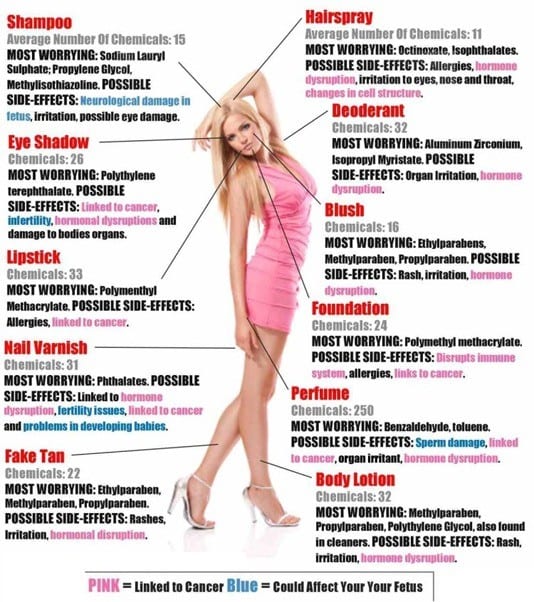
Insoluble nanoparticles in cosmetic products are essentially used as UV filters or preservatives.
Insoluble nanoparticles in cosmetic products are essentially used as UV filters or preservatives. Nanoparticles alter the properties of cosmetic products including color, transparency, solubility, and chemical reactivity.
It is unclear to what extent insoluble nanoparticles are used in cosmetic products.
FOUND IN: deodorants, kinds of toothpaste, shampoos, lotions, foundation, anti-aging creams, and nail polish.
WHAT TO LOOK FOR ON THE LABEL: Fullerenes, micronized zinc oxide, Nano zinc oxide, micronized titanium dioxide, micronized quartz silica.
WHAT ARE NANOMATERIALS?: There is no legal definition for nanomaterials. Typically, they are defined as purposely engineered materials with at least one dimension between 1 and 100 nanometers, which is about 1/8000 the width of a human hair. At this size, materials begin to exhibit unique properties that affect physical, chemical, and biological behavior.
There is no single type of nanomaterial. They can differ with respect to composition, primary particle size, shape, surface coatings, and strength of particle bonds.
HEALTH CONCERNS: Studies have indicated that low-solubility nanoparticles tend to be more toxic than larger particles of the same material. However, we know very little about the potential effects on human health and the environment due to research gaps related to asphalt.
WHAT TO LOOK FOR ON THE LABEL: Mica, muscovite
WHAT IS MICA? Mica minerals are often used as color additives in cosmetics. They also have reflective properties, allowing for a shimmery effect in mineral foundations. Long-term inhalation of mica poses a health risk to workers, specifically those working in muscovite (the most common form of mica) mills and other occupations such as agriculture and construction work.
HEALTH CONCERNS: Irritation
VULNERABLE POPULATIONS: Workers in cosmetic manufacturing factories, mines, mills, agriculture, and construction work.
REGULATIONS: The National Institute for Occupational Safety and Health has set recommended exposure limits and the Occupational Safety and Health Administration has set permissible exposure for an average workday.
HOW TO AVOID: Proper industrial hygiene practices should be followed, such as appropriate. Mica use in cosmetics is not a concern for consumers.
Homosalate is a widely used chemical in sunscreens and skin care products with SPF. Homosalate is a potential endocrine disruptor and…
Homosalate is a widely used chemical in sunscreens and skin care products with SPF. Homosalate is a potential endocrine disruptor and studies in cells suggest it may impact hormones. In addition to direct health concerns following homosalate exposure, the chemical may also enhance the absorption of pesticides in the body.
FOUND IN: Sunscreen, Skin Care Products with Sun Protection.
WHAT TO LOOK FOR ON THE LABEL: Homosalate, Homomenthyl salicylate, HMS, HS; 3,3,5-trimethyl-cyclohexyl-salicylate
Exposure to nanomaterials may happen through the skin or inhalation. The skin may be permeable to nanomaterials of different shapes and properties. Short-term inhalation may lead to exposures that are retained in the lung and other organs after six months.
There is evidence that following nasal inhalation some nanoparticles may reach the brain. Iridium nanoparticles circulating in the blood can cross the blood-brain barrier. Several in vivo studies have shown that inhaled ultrafine particles can pass into the circulation.
VULNERABLE POPULATIONS: Everyone.
REGULATIONS: The FDA monitors the use of nanotechnology and the use of nanoscale materials in cosmetics, but does not ban nanomaterials. The European Commission prohibits the use of zinc oxide as a UV filter.
HOW TO AVOID: Research has shown nanoized particles can be potentially harmful when inhaled. Avoid loose cosmetic powders and aerosol sunscreen products that contain nanoized TiO2 or ZnO. Don’t forget to check the ingredient labels of your personal care products.
Homosalate is an organic compound that belongs to a class of chemicals called salicylates. Salicylates prevent direct skin exposure to the sun’s harmful rays by absorbing ultraviolet (UV) light. Homosalate specifically absorbs short-wave UVB rays, which are associated with DNA damage and an increased risk of skin cancer.
HEALTH CONCERNS: Endocrine disruption, skin absorption.
VULNERABLE POPULATIONS: Pregnant/lactating women, nursing infants, agricultural workers, and people with habitual exposures to pesticides such as at parks or on lawns.
HOW TO AVOID: Read labels and avoid products with Homosalate. Choose a cream or lotion-based sunscreen with zinc oxide or titanium dioxide.
FRAGRANCE
Many products list “fragrance” on the label, but very few name the specific ingredients that make up a “fragrance.” This lack of disclosure prevents consumers from knowing the full list of ingredients in their products. While most fragrance chemicals are not disclosed, we do know that some are linked to serious health problems such as cancer, reproductive and developmental toxicity, allergies, and sensitivities.
Clearly, there is a need for stronger regulations, more research, and greater transparency.
FOUND IN: Most personal care products including sunscreen, shampoo, soap, body wash, deodorant, body lotion, makeup, facial cream, skin toner, serums, exfoliating scrubs, and perfume.
WHAT TO LOOK FOR ON THE LABEL: Fragrance, perfume, parfum, essential oil blend, aroma.
WHAT IS FRAGRANCE? The fragrance is defined by the FDA as a combination of chemicals that give each perfume or cologne (including those used in other products) its distinct scent. Fragrance ingredients may be derived fr from petroleum or natural raw materials. Companies that manufacture perfume or cologne purchase fragrance mixtures from fragrance houses (companies that specialize in developing fragrances) to develop their own proprietary blends.
In addition to “scent” chemicals that create the fragrance, perfumes, and colognes also contain solvents, stabilizers, UV absorbers, preservatives, and dyes.
HEALTH CONCERNS: The International Fragrance Association (IFRA) lists 3,059 materials that are reported as being used in fragrance compounds. Of these 3,059 ingredients, some have evidence linking them to health effects including cancer, reproductive toxicity, allergies, and sensitivities.
A 2016 study assessed the self-reported health effects of fragrance. This survey of a random sample of US residents found that 99.1% of participants are exposed to fragrance products at least once a week for their own use, others’ use, or both. Participants also reported an extensive list of health effects experienced when exposed to fragrance ranging from migraines and asthma to gastrointestinal problems and cardiovascular problems.
The findings showed that a high percentage of the participants did not know of the chemicals included in fragrance and would not continue to use a fragranced product if they had previously known it emitted pollutants.
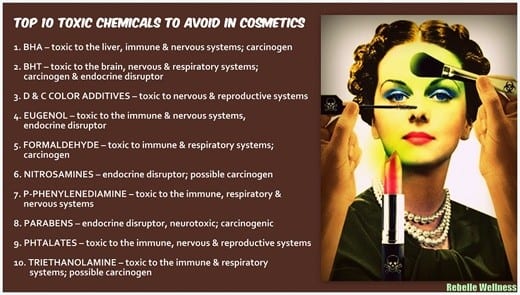
Acetaldehyde:
Acetaldehyde adversely affects the kidneys and the reproductive, nervous, and respiratory systems. This chemical is listed as known or suspected to cause cancer in California’s Proposition 65. Both the International Agency for Research on Cancer and the National Toxicology Program classifies acetaldehyde as potentially carcinogenic to humans.
Benzophenone:
Benzophenone is linked to endocrine disruption and organ system toxicity, and experimental studies suggest benzophenone may lead to several kinds of tumors. Derivatives of benzophenone, such as benzophenone-1 (BP-1) and oxybenzone (BP-3), are potential endocrine disruptors. Benzophenone is listed as a possible human carcinogen under California’s Proposition 65.
VULNERABLE POPULATIONS: All, especially pregnant women, and infants.
REGULATIONS: Current laws do not provide the FDA with the authority to require disclosure or public safety of fragrance ingredients. In the U.S., companies are required to list ingredients on the label; however, this regulation excludes the individual constituents of fragrance in order to preserve fragrance trade secrets. This sustains a loophole that leads to disclosure gaps.
The International Fragrance Association (IFRA) and the Research Institute for Fragrance Materials (RIFM) develop and set voluntary standards for chemicals in the “fragrance” component of products. The US, Canada, and Europe rely on IFRA and RIFM to identify ingredients for use in fragrance. In effect, this means the international Fragrance industry is self-regulating.
HOW TO AVOID: Read labels and avoid products when no information is given other than “fragrance”.
Acrylates (ethyl acrylate, ethyl methacrylate, and methyl methacrylate) are ingredients found in artificial nail products. We are mainly exposed to these chemicals through inhalation or skin contact. Despite evidence of adverse skin, eye, and throat reactions to these chemicals, they continue to be used in nail products.
FOUND IN: Artificial Nail Products (Acrylic Nails, Nail Enhancing Polishes)
WHAT TO LOOK FOR ON THE LABEL: ethyl acrylate: Acrylic acid ethyl ester, ethyl propenoate, EA; ethyl methacrylate: ethyl methacrylate, ethyl ester, methacrylic acid, ethyl ester, ethyl 2-methyl-2-propenoate, EMA; methyl methacrylate: Methacrylate monomer, Methyl ester of methacrylic acid, methyl-2-methyl-2-propenoate, MMA
WHAT ARE ACRYLATES? Acrylates are derived from acrylic acid and are commonly found in cosmetic nail preparations. Ethyl acrylate acts as an adhesive to apply artificial nails and eyelashes. Ethyl methacrylate and methyl methacrylate allow sculptured artificial nails to mold and adhere to the natural nail plate.
HEALTH CONCERNS: Health concerns include cancer, developmental and reproductive toxicity, organ system toxicity, cellular and neurological damage, and irritation.
REGULATIONS: Although the Food and Drug Administration banned 100 percent liquid methyl methacrylate in 1974, no specific regulations prohibit its use at concentrations lower than 100 percent in cosmetic products. Across the United States, at least 32 states ban the professional use of methyl methacrylate in nail salons. Still, the FDA found trace amounts in 15 to 25 random samples of the chemical in powdered form and reports that it continues to be found in artificial nail products.
Air samples from 12 randomly selected nail salons in Salt Lake City County in Utah, which banned methyl methacrylate, found 58 percent of the salons had methyl methacrylate circulating in the air. Considering the corrosive and skin-sensitizing properties of ethyl methacrylate and methyl methacrylate, the Methacrylate Producers Association, Inc. has stated that these chemicals are not appropriate for artificial nail products. Yet, they continue to be ingredients.
HOW TO AVOID: Avoid using artificial nails unless you know that they do not contain acrylates. Nail technicians should use ventilated manicure tables and wear appropriate safety masks and protective gloves. The Occupational Safety and Health Administration recommends NIOSH-approved filtering facepiece respirators (e.g. dust masks) and nitrile gloves.
Not all cosmetics have these harmful toxins in them. It is very important that you read the labels and see what goes into the cosmetics that you choose to use.
Thank you for reading,
Michael.
Comments are welcome.
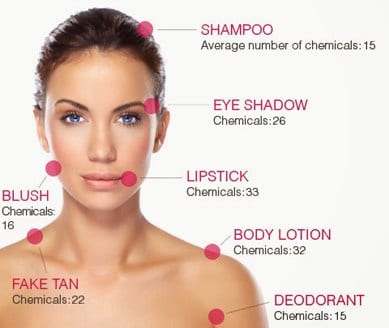
Thanks so much for sharing this post that will help so many women to make the right choice when it comes to choosing cosmetics. I did not know that many of them contain chemicals that are harmful which I think is so serious. Something like this should be stopped because companies that are engaged in this type of activity are putting so many persons’ health at risk. Thanks so much for sharing because this is a real eye-opener to me and I am sure to so many.
Hi Norman,
Thank you for your comments. I remember Johnson and Johnson’s Baby powder. My mum used it all the time. Over the years we find out it causes cancer. I remember smoking cigarettes, it was determined it caused cancer. I remember the time when emission standards had to be changed. Certain companies are using lead in their lipsticks, talc powder, sunscreen… the list goes on. They changed the name of the toxins they were using, and are continuing to use the same products. Money is a very influential source, and the big companies are able to buy out the regulatory committees that govern these products. It is kind of sad to me.
All the best,
Michael
I must say that I am so much intrigue by your your effort in putting up such and informative article on the side effects of toxic cosmetic chemicals which could lead to cancer…really amazing review you’ve made here I look forward to share it on my blog so that others could be careful henceforth on the skincare products that they make use of on your skin..
Hi evansese,
Than you for your comments. I think it is really important that people are made aware of these toxic chemicals including lead contained in commonly used cosmetics.
All the best,
Michael
Heloo there, a big thanks to you for sharing this insightful and informative piece on toxic cosmetics chemicals. Dangeers cancer. As a matter of fact I actually stumbled on this site which I must say is really amazing and I am so lucky, it’s so filled with quality and useful content that could save life. Now my eyes are open the the reality of the dangers of some chemicals. Thanks once again for this.
Hi Thousand,
Thank you for your comments. What is more important, makeup to look beautiful or your health?
All the best,
Michael
I must say that I admire your courage in putting up such an information review on toxic cosmetic chemicals dangers in various products.. a lot of skin care companies actually uses much of dangerous chemicals that they really do give other names so that they wont easily noticed… these chemicals in turn could cause severe damages to your skin… thanks a lot for such an informative review
Hi evans,
Thank you for your comments. It is kind of risky when you say negative things against big companies. I do feel people’s health comes first.
All the best,
Michael
Hey nice article you have there, your thoughts are indeed invaluable. It is important for manufacturers to state the accurate ingredients used in producing their products. Many a time some manufacturers do not state some chemicals and hat are harmful to health and skin on their labels, this is indeed unethical on their part, as it can lead customers astray thereby having an adverse effects on their well-being
Hi, edahnewton,
Thank you for your comments. Money and profit always seem to come first.
Best wishes,
Michael